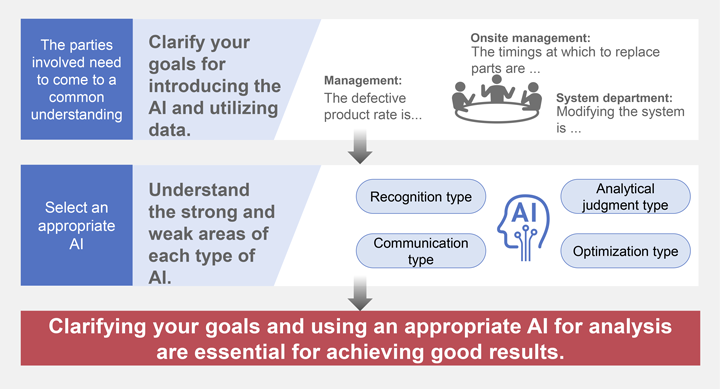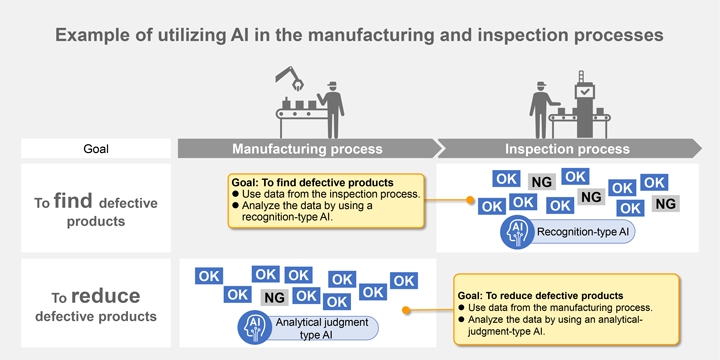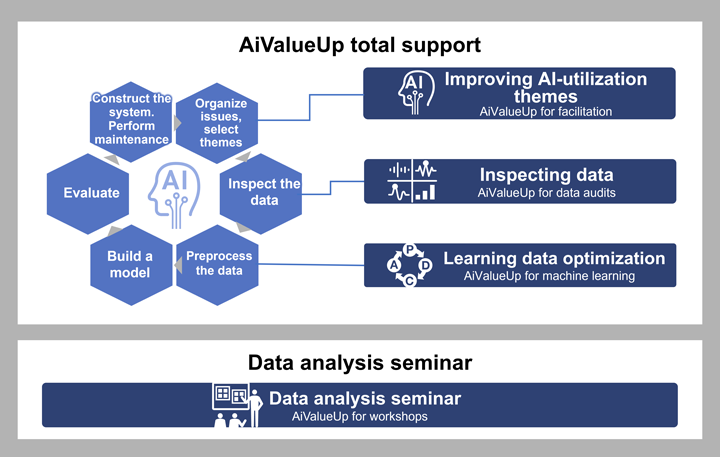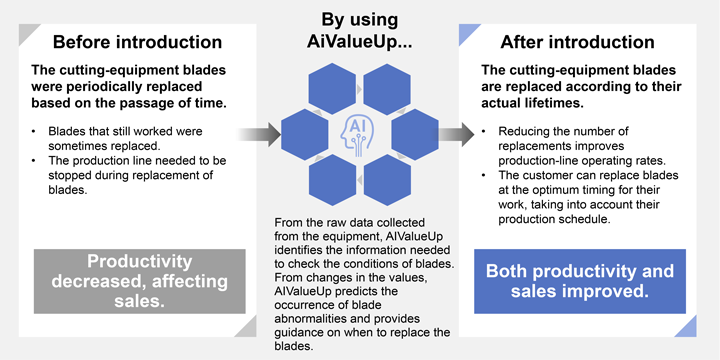Featured customer case
Lumada customer case code: UC-01926S
AiValueUp polishes collected data and enhances its value
2022-12-16

Using AI (artificial intelligence) analysis to solve business issues has attracted attention in recent years. The key to utilizing AI to solve issues is to be able to polish collected raw data from a business perspective and process it into data suitable for analysis.
This document describes a general approach for using AI to solve business issues and also gives an actual customer case in which the customer learned the importance of preprocessing. We used a general-purpose AI model to solve on-site issues by sharing expertise through a co-creation approach and by polishing data.
We are able to flexibly respond to a wide variety of customer needs to resolve their issues: from providing compact individual support items, to total support that includes design and construction of systems using AI.
In addition, for customers who want to promote data utilization on their own, we support in-house production by providing unique human resource development (education seminars).
Co-creation with Lumada! Predicting the lifetimes of consumables
Consumable parts in equipment at manufacturing sites deteriorate day by day, with damage resulting from wear and deformation. Such deterioration and damage can lower product quality and result in equipment failures. For this reason, many sites periodically replace parts based on the number of times and the length of time the parts have been used.
Equipment operating at a worksite must be regularly maintained to prevent failures on the production line. Usually, this requires replacing the consumable parts in the equipment. However, there are cases in which consumable parts are replaced even if they are still usable because there are many types and numbers of parts and it is difficult to understand the condition of each part. As a general approach, most companies replace parts earlier than is necessary to avoid failures caused by deterioration or damage. This increases the frequency of replacements, and the resulting equipment stoppages for the replacements decrease production-line operation rates.
At most sites, staff understand that using the data collected from the equipment allow them to replace parts at the right time and also understand that AI is a good way of utilizing huge amounts of data. However, in many cases, the introduction of AI and the utilization of data have failed for reasons such as the various stakeholders did not have a consistent image of what is required to successfully introduce AI. Even when they attempted to use the collected data as-is for analysis and learning, the results were poor.

If the parties involved (such as executive management, onsite management, and the information system department) do not have a consistent image of what is required to successfully introduce AI, first the parties need to agree on the basic idea that, “We will use the AI to analyze data and obtain results.” After that, the parties need to clarify their goals for introducing the AI, and then select a specific AI suitable for those goals. There are multiple types of AI, specializing in different areas. For example, some specialize in being able to recognize patterns in images, and others specialize in chatbot-type communications. Selecting an appropriate type of AI that matches your goals and selecting its desired features are the first steps towards introducing AI and utilizing your data.

Massive amounts of raw data are collected, and the content of this data needs to be understood and processed into a format and content suitable for analysis by AI. Preprocessing this data enables the data to be utilized to the maximum extent and improves the accuracy of AI analysis.
If you can introduce an AI and analyze data to predict equipment abnormalities, you will be able to optimize the timing for carrying out replacements of consumable parts. This enables you to reduce the frequency at which consumable parts are replaced, which leads to reduced maintenance costs. In addition, optimizing the timing reduces the number of times the production line needs to stop for part replacements, so you can expect to maintain and improve your production-line operation rates, as well as improve productivity and sales.
AI for business can be broadly classified into the following four types:
For example, if the parties involved agree their goal for introducing an AI is to improve product quality, they need to select a type of AI appropriate for the measures to be implemented.
By using the right type of AI to analyze polished data, you can obtain results that will improve your business.

Data preprocessing is essential to obtain useful results in AI analysis and is the most important process in the overall analysis. However, there are many cases in which this preprocessing is considered as just a type of data shaping: for example, people incorrectly assume that the goal is just to identify names and align axes.
If you treat data preprocessing as just an accessory to the introduction of AI and data utilization and leave it to external data scientists, the preprocessing will not incorporate your business knowledge related to OT (operational technology). This can easily lead to failed introductions of AI at worksites and an inability to utilize your data to its maximum potential.
Hitachi focuses on this point and proposes preprocessing that polishes the data and increases its value. (The Value Up in AiValueUp.) We support initiatives that emphasize co-creation of expertise, including a menu of items for developing human resources to a practical level, which enables the customer to learn what is required to successfully introduce AI and utilize data.
Enhancing the value of data
To utilize massive amounts of data in order to improve business, the collected raw data must be preprocessed into a format and content suitable for AI analysis. AiValueUp polishes such data and enhances its value through preprocessing based on various perspectives, experience, and logic.

The following process flow is used to achieve excellent results from data: organize the issues, select the themes, inspect the data, preprocess the data, build a model, evaluate it, construct the system, and maintain the model and system.
AiValueUp supports all of these processes and provides the “AiValueUp total support” service which can design and construct a model/system from scratch according to the customer’s business issues. In addition, this solution also provides menu items that support the individual tasks of organizing issues, selecting themes, inspecting data, and preprocessing data. Customers frequently request support for such tasks.
In addition, this solution provides “Data analysis seminar: AiValueUp for workshops” to support the development of the customers’ human resources. This solution enables customers to acquire data analysis skills through training with practical content, so that the customers can promote data utilization on their own.
We will now introduce an actual case of a manufacturing site where we analyzed equipment data polished by AiValueUp and confirmed the result improved maintenance operations.
A textile manufacturer was unable to check the condition of its equipment, and so they performed maintenance based on the passage of time. The blades of the cutting equipment were replaced early, regardless of their actual lifetime. As a result, the frequency of replacement became high, and the production-line operation rates decreased due to the equipment stoppages during replacement. In some cases, the removed blade was still usable, so the manufacturer faced the issue of revising the replacement frequency.
For this issue, Hitachi proposed the solution that used AiValueUp to identify the information that could be used to check the conditions of blades from various data collected from the equipment, obtained feature values from changes in the values related to the occurrence of blade abnormalities, and then predicted the condition of the equipment based on those changes. In this way, the system could provide guidance on when to replace blades based on predictions of blade abnormalities. These predictions were based on empirical data on the actual conditions. This resulted in improved operation because the frequency of blade replacement was reduced and the customer could improve their production-line operation rates.

By switching from time-based maintenance to condition-based maintenance, the manufacturer could obtain the following results.
Hitachi promotes data utilization that contributes to worksites and management. To do this, we implement a cycle that combines collected data, analyzes and turns it into valuable information, and then utilizes it to solve on-site issues.
Furthermore, our efforts to use data to connect management and worksites to improve work efficiency and save labor are a step toward the future. We are aiming for complete automation of the manufacturing industry and not just improved work efficiency and labor savings.
For details on our solutions, see the following webpages.
We are able to flexibly respond to a wide variety of customer needs to resolve their issues: from providing compact individual support items, to total support that includes design and construction of systems using AI.
In addition, for customers who want to promote data utilization on their own, we support in-house production by providing unique human resource development (education seminars).